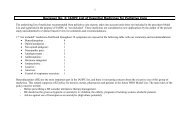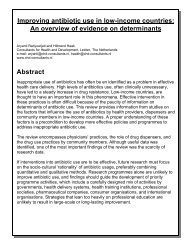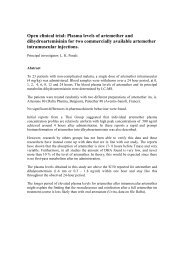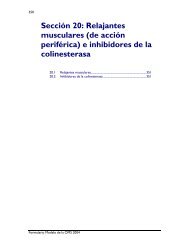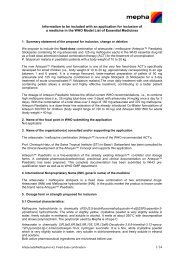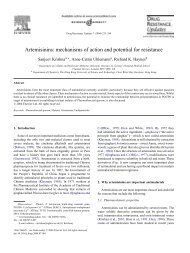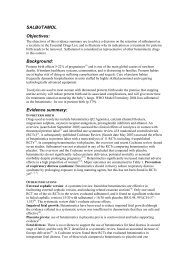Application for the inclusion of Aciclovir eye ointment in the WHO list ...
Application for the inclusion of Aciclovir eye ointment in the WHO list ...
Application for the inclusion of Aciclovir eye ointment in the WHO list ...
Create successful ePaper yourself
Turn your PDF publications into a flip-book with our unique Google optimized e-Paper software.
4. International Nonproprietary Name (INN, generic name) <strong>of</strong> <strong>the</strong> medic<strong>in</strong>e<br />
<strong>Aciclovir</strong> <strong>o<strong>in</strong>tment</strong>, chemically denoted 9-(2-Hydroxyethoxymethyl) guan<strong>in</strong>e)) 2<br />
5. Formulation proposed <strong>for</strong> <strong><strong>in</strong>clusion</strong><br />
<strong>Aciclovir</strong> 3.0% W/W <strong>o<strong>in</strong>tment</strong><br />
FOR OPHTHALMIC USE ONLY<br />
6. International availability – sources, manufactures<br />
Zovirax ® <strong>eye</strong> <strong>o<strong>in</strong>tment</strong> is a registered trademark <strong>of</strong> <strong>the</strong> GlaxoSmithKl<strong>in</strong>e group<br />
<strong>of</strong> companies.<br />
O<strong>the</strong>r <strong>in</strong>ternational sources <strong>in</strong>clude:<br />
IDA Foundation<br />
Missionpharma<br />
Durb<strong>in</strong><br />
7. Whe<strong>the</strong>r <strong>list</strong><strong>in</strong>g is requested as an <strong>in</strong>dividual medic<strong>in</strong>e or as an example<br />
<strong>of</strong> a <strong>the</strong>rapeutic group<br />
Individual medic<strong>in</strong>e<br />
8. In<strong>for</strong>mation support<strong>in</strong>g <strong>the</strong> public health relevance (epidemiological<br />
<strong>in</strong><strong>for</strong>mation on disease burden, assessment <strong>of</strong> current use, target<br />
population)<br />
Herpes simplex is probably <strong>the</strong> most common virus acquired by humans. It is<br />
usually acquired <strong>in</strong> early life, one study f<strong>in</strong>d<strong>in</strong>g antibodies aga<strong>in</strong>st <strong>the</strong> virus <strong>in</strong><br />
50% <strong>of</strong> subjects with high socioeconomic status and <strong>in</strong> 80% <strong>of</strong> people with low<br />
socioeconomic status by <strong>the</strong> age <strong>of</strong> 30 years. 3 Humans are <strong>the</strong> only natural host<br />
and reservoir <strong>for</strong> <strong>the</strong> virus and antiviral drugs do not elim<strong>in</strong>ate latent virus. Thus<br />
bl<strong>in</strong>dness due to herpes virus rema<strong>in</strong>s a significant public health problem.<br />
The <strong>in</strong>cidence <strong>of</strong> ocular HSV is estimated at 21 to 31 per 100,000 people per<br />
year 4,5 and worldwide, up to 10 million people are thought to have a history <strong>of</strong><br />
ocular HSV. 6 Data from a long term study <strong>in</strong> Rochester, MN, USA, suggested<br />
that approximately 400,000 Americans have had ocular herpes and that<br />
approximately 50,000 episodes <strong>of</strong> new and recurrent ocular HSV <strong>in</strong> <strong>the</strong> USA<br />
occur annually. 5<br />
Ocular surface disease occurs predom<strong>in</strong>antly <strong>in</strong> two <strong>for</strong>ms. Dendritic epi<strong>the</strong>lial<br />
keratitis is virtually pathonemonic <strong>of</strong> HSV whereas geographic epi<strong>the</strong>lial keratitis,<br />
2



